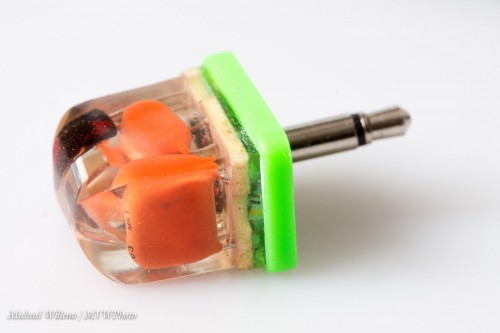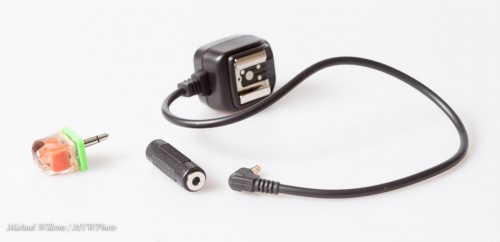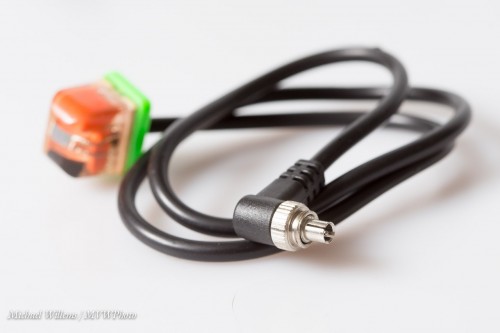Gadget Recommendation Time here at speedlighter.ca!
I often use “studio type” flash. This, by my definition, is flash…
- Whose power is set manually, and…
- Which is fired with a simple “fire now” command, rather than through TTL (“Through The Lens”) metering.
Strobes are all like that. Speedlights can optionally also be used this way.
Outdoors, I use Pocketwizard II Plus radio triggers to fire studio-type flashes. They use radio to convey that simple “fire” command: one on the camera, working as a sender, and one on each flash, working as a receiver. Click, and all flashes go off. Simple.
In indoor studio situations like the one pictured below, if I have strobes, I use Pocketwizards combined with “cell” sensors. Studio lights have light sensitive cells that detect a flash, and that fire when they see such a flash. So one studio light has a Pocketwizard; the others use their light sensitive cell.
The catch: Studio lights have that “cell” ability, but Canon speedlites do not. (Some Nikon speedlights do have it: with the usual Japanese ability to use obscure terms, they call it “SU-4” functionality).
So if I want to use four Canon speedlights, as above, I need five Pocketwizards. Each of which cost a couple of hundred dollars; and then I need a special cable to connect the Pocketwizard to the speedlight.
Enter the new Flashzebra.com Optical Slaves. These are small and very affordable sensors with a light cell, that connect to your Canon flash. They need no external power: all you do is plug them in, set the flash to manual mode at your selected power level, and you have a slave flash!
These slave cells come in various versions. One has a standard 3.5 mm jack:
You would use this for any Canon flash, by means of a female-female converter and a special Canon hotshoe cable, some of which I already own:
There are also options that plug directly into the flash if it has a PC-type flash connector (the one with the concentric rings; such as a 580EX II). See on the left:
Also, the same, but with a cable:
There are many other variants, as you can see here:
http://www.flashzebra.com/opticalslaves/index.shtml
I just used one of them to make all these pictures, by the way. Here you can see it, plugged straight into the PC connector of my 580EX II:
So, why am I happy with these optical slave devices?
- First, they are simple and do not require a whole lot of cables, brackets, and so on.
- There are Canon-specific versions available.
- I do not need to worry about their batteries running out.
- I save significant money, since now I do not need as many Pocketwizards.
When do I not use optical slaves?
- When I am outdoors, certainly on a bright day. Unless I have very reliable line of sight, optical slaves are not great outdoors.
- When the range is too great. Pocketwizards can cover hundreds of metres.
- When I am using any sort of TTL. TTL (“Automatic flash”) uses a pre-flash, as my readers here know well; this pre-flash would set off the slave flashes, so that a few milliseconds later, when the shutter opens and the “real” flash goes, the speedlight is not yet ready.
So now I am ready to roll with even more small, light and affordable options. And I like small, light, and affordable.
How well are these optical slaves made? They are cheap (made in India!), but that does not mean they will break. They seem solid enough. I shall do a long duration test, but for $16, I am not too bothered if any of them ever break: I’ll get more. More important is that they do not damage my flashes, as such devices can; I am happy to report that everything is fine.
I have been buying from Flashzebra for years, and recommend them wholeheartedly, and I am not being paid to say this: I love their range of affordable cables, brackets, and other flash gadgets, and I am always very happy with their service, should I need it.
Flashzebra.com for flash gadgets and Honlphoto.com for small flash modifiers: these are my goto places for flash needs. And yes, Dave Honl is a friend but no, he is not paying me to say this either!
___
Allow me to point out these few additional learning opportunities:
- My photo eBook is out: www.speedlighter.ca/photography-cookbook/
- All-day workshop “The Art of Shooting Nudes” on March 2 in Hamilton, Ontario, and there are still places available: www.cameratraining.ca/Nudes.html
- Advanced Flash workshop, also in Hamilton, 17 February (booking page soon)
All workshops will be announced via email and press release next week, but you, my readers here, get first option!







The Advanced Flash Workshop is probably not on 17 of January, seeing as how it’s the 22 of January now.
…unless you’ve discovered time travel, in which case, please share! I’d very interested 🙂
Aha! Yes, I meant 17 February! Corrected shortly.. thanks.
And I do time travel all the time. But alas, only one way.
I don’t think you can do this with plug-in slave cells, but the integral slave cells in some flashes (such as my YN-560s) have “S1” and “S2” modes. In the former, they fire on the first pulse they see; in the latter, they ignore the first (TTL metering) pulse and fire on the second (main) pulse.
I’m not sure if this feature is of any practical use, considering that they’re purely manual flashes. Letting the camera choose its own exposure according to its built-in preflash, then blasting off a bunch of manual strobes after the shutter opens, doesn’t seem to make much sense. But the feature does exist, if you can think of a reason to use it…